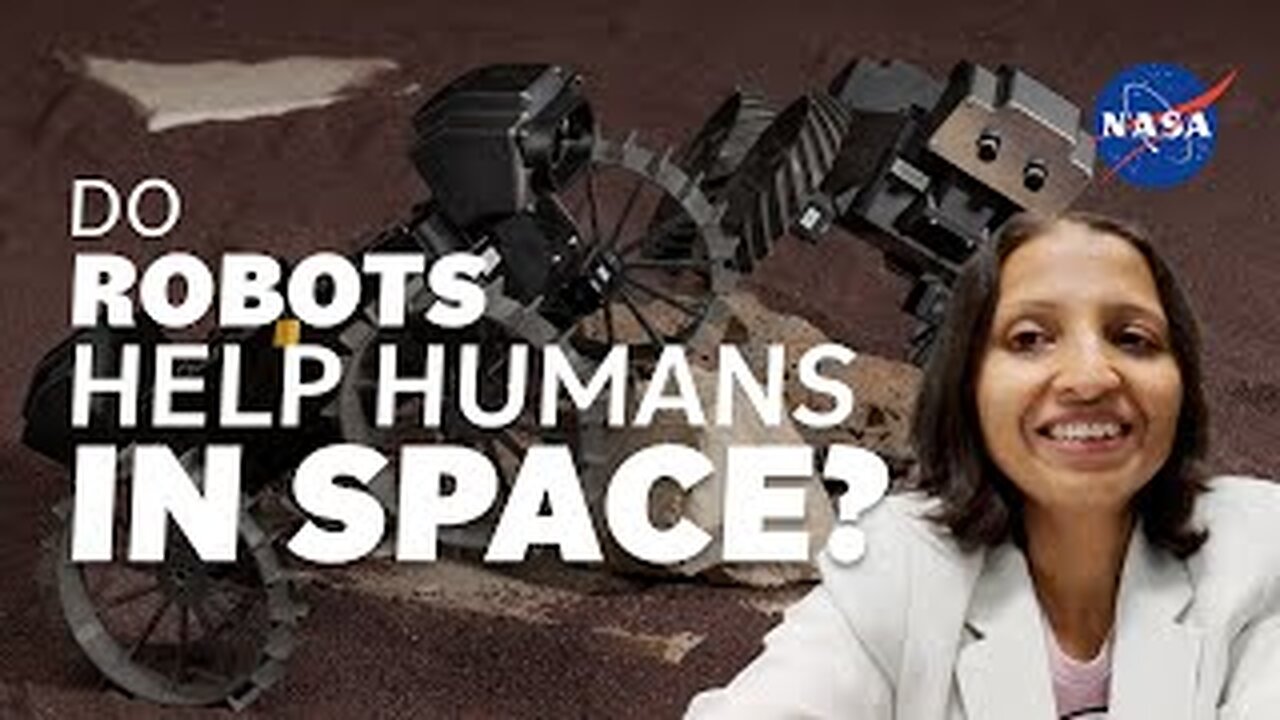Premium Only Content

Do Robots Help Humans in Space? We Asked a NASA Technologist
When it comes to space, humans and robots go way back. We rely heavily on our mechanical friends to perform tasks that are too dangerous, difficult, or out of reach for us humans. We’re even working on a new generation of robots that will help us explore in advanced and novel ways.
Learn more about the CADRE—Cooperative Autonomous Distributed Robotic Exploration—project and how this new network of mini rovers could enable future self-guided robotic exploration of the Moon, Mars, and beyond. https://go.nasa.gov/3k5EuZx
Producers: Scott Bednar, Jessica Wilde
Editor: James Lucas
We know the Moon contains water, but, could future astronauts access and make use of it? That’s the goal. At NASA, we’re actively trying to answer that question. Once it lands at the lunar south pole, our PRIME-1 — Polar Resources Ice Mining Experiment-1 – will robotically sample and analyze ice from beneath the lunar surface, contributing to our search for water on the Moon
Dr. Joseph Lazio (NASA's Jet Propulsion Laboratory) shared how NASA’s Deep Space Network helps in our exploration of the Solar System and beyond in a webinar held with Night Sky Network member
About This Talk
Nearly every image of another planet that was taken by a NASA spacecraft has been transmitted to us through one or more antennas of NASA’s Deep Space Network (DSN). For almost the past 60 years, the DSN has been guiding spacecraft to their destinations across the Solar System, sending them commands for actions to take upon reaching their destinations, and receiving the data back from them. Moreover, the DSN is a science instrument in its own right. In this Webinar, I will review what the DSN is, how it enables NASA missions throughout the Solar System and beyond, and illustrate some of the scientific measurements that it makes on its own.
About Dr. Joseph Lazio
Joseph Lazio is the Interplanetary Network Directorate Scientist at the Jet Propulsion Laboratory, California Institute of Technology. He received his Ph.D. from Cornell University, was a National Research Council Research Associate at the U.S. Naval Research Laboratory, and was a Radio Astronomer on the staff of the Naval Research Laboratory, before joining JPL. He is the Project Scientist for the Sun Radio Interferometer Space Experiment (SunRISE) mission, and he has served as Project Scientist for the Square Kilometre Array (SKA); the Deputy Director of the Lunar University Network for Astrophysics Research (LUNAR), part of the NASA Lunar Science Institute; and the Project Scientist for the U.S. Virtual Astronomical Observatory. He also observes routinely with the world's premier ground-based radio telescopes, including the Expanded Very Large Array, the Very Long Baseline Array, and the Green Bank Telescope
A commercial resupply mission heads to the space station, a key piece of hardware for a future Moon mission is on the move, and another spacecraft gets ready to spread its wings in deep space … a few of the stories to tell you about – This Week at NASA!
Link to download this video: https://images.nasa.gov/details/A%20C...
Video Producer: Andre Valentine
Video Editor: Andre Valentine
Narrator: Andre Valentine
Music: Universal Production Music
Credit: NASA
We know the Moon contains water, but, could future astronauts access and make use of it? That’s the goal. At NASA, we’re actively trying to answer that question. Once it lands at the lunar south pole, our PRIME-1 — Polar Resources Ice Mining Experiment-1 – will robotically sample and analyze ice from beneath the lunar surface, contributing to our search for water on the Moon
Dr. Joseph Lazio (NASA's Jet Propulsion Laboratory) shared how NASA’s Deep Space Network helps in our exploration of the Solar System and beyond in a webinar held with Night Sky Network member
About This Talk
Nearly every image of another planet that was taken by a NASA spacecraft has been transmitted to us through one or more antennas of NASA’s Deep Space Network (DSN). For almost the past 60 years, the DSN has been guiding spacecraft to their destinations across the Solar System, sending them commands for actions to take upon reaching their destinations, and receiving the data back from them. Moreover, the DSN is a science instrument in its own right. In this Webinar, I will review what the DSN is, how it enables NASA missions throughout the Solar System and beyond, and illustrate some of the scientific measurements that it makes on its own.
About Dr. Joseph Lazio
Joseph Lazio is the Interplanetary Network Directorate Scientist at the Jet Propulsion Laboratory, California Institute of Technology. He received his Ph.D. from Cornell University, was a National Research Council Research Associate at the U.S. Naval Research Laboratory, and was a Radio Astronomer on the staff of the Naval Research Laboratory, before joining JPL. He is the Project Scientist for the Sun Radio Interferometer Space Experiment (SunRISE) mission, and he has served as Project Scientist for the Square Kilometre Array (SKA); the Deputy Director of the Lunar University Network for Astrophysics Research (LUNAR), part of the NASA Lunar Science Institute; and the Project Scientist for the U.S. Virtual Astronomical Observatory. He also observes routinely with the world's premier ground-based radio telescopes, including the Expanded Very Large Array, the Very Long Baseline Array, and the Green Bank Telescope
A commercial resupply mission heads to the space station, a key piece of hardware for a future Moon mission is on the move, and another spacecraft gets ready to spread its wings in deep space … a few of the stories to tell you about – This Week at NASA!
Link to download this video: https://images.nasa.gov/details/A%20C...
Video Producer: Andre Valentine
Video Editor: Andre Valentine
Narrator: Andre Valentine
Music: Universal Production Music
Credit: NASA
-
 15:35
15:35
Demons Row
12 hours agoThe Worst Sgt-at-Arms I Ever Met 💀🔥 (and the Mistakes I Made as One)
6.49K1 -
 9:34
9:34
Sideserf Cake Studio
22 hours ago $0.25 earned484 Lego Bricks. 1 Hyperrealistic Cake.
5.3K1 -
 22:42
22:42
marcushouse
22 hours ago $0.79 earnedMassive Surprises From Starship Flight 11 Revealed! 🤯
6.98K7 -
 14:08
14:08
Forrest Galante
9 hours agoPrivate Tour Of the World's Most Expensive Pet Show
129K9 -
 13:50
13:50
Nikko Ortiz
19 hours agoStop Hurting Yourself For Views.
13.8K7 -
 2:07:06
2:07:06
Side Scrollers Podcast
1 day agoDiaper Furry Streamer Gets ONLY ONE DAY Suspension + Hasan PLAYS VICTIM + More | Side Scrollers
44.2K22 -
 56:38
56:38
DeProgramShow
1 day agoDeprogram with Ted Rall and John Kiriakou: "Jake Tapper on the Global Hunt for an Al Qaeda Killer”
10.6K4 -
 1:43:07
1:43:07
The Michelle Moore Show
2 days ago'The 12 Open Doors' Guest, Steve Jarvis: The Michelle Moore Show (Oct 17, 2025)
21K11 -
 LIVE
LIVE
Lofi Girl
3 years agolofi hip hop radio 📚 - beats to relax/study to
103 watching -
 1:45:06
1:45:06
Badlands Media
1 day agoDevolution Power Hour Ep. 399: No Kings, Antifa’s Collapse & Trump’s Year of Peace
288K93